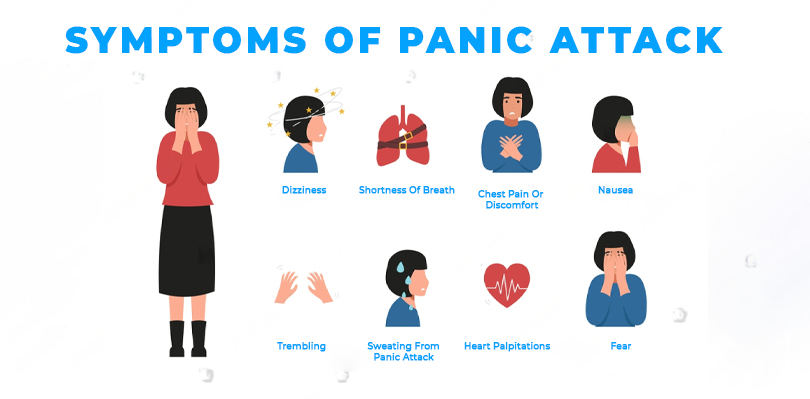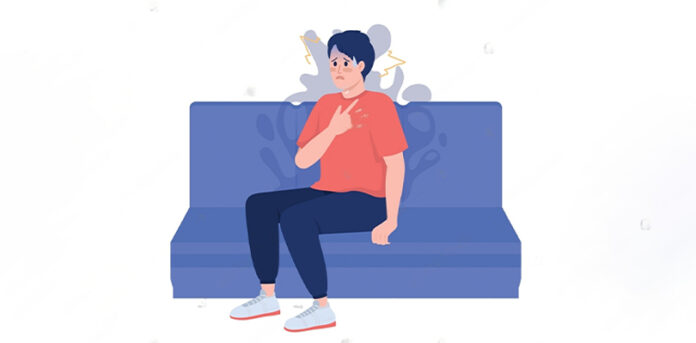Panic attack are more common than you might think, and they don’t necessarily mean you have a serious medical condition. With the right techniques, you can control and prevent panic attacks from happening. Panic attacks can be a terrifying and overwhelming experience, and they can strike without warning.
For those who have experienced them, the symptoms can be all too familiar: heart palpitations, sweating, shaking, shortness of breath, and a feeling of impending doom. Panic attacks can be difficult to control, but with the right techniques and mindset, they can be managed. In this blog post, we’ll discuss the symptoms of a panic attack, how to prevent them, and what to do if you experience one.
Symptoms Of Panic Attack

A panic attack is an episode of intense fear or discomfort that can happen suddenly, without any apparent trigger or warning. During a panic attack, a person may experience a range of physical, emotional, and cognitive symptoms that can be overwhelming and frightening. Here are 7 common symptoms of panic attacks in detail:
Heart Palpitations Or A Racing Heartbeat
During a panic attack, a person may feel like their heart is pounding or racing. They may feel like their heart is going to beat out of their chest, and they may be able to feel their heartbeat in their neck, throat, or ears. This symptom can be particularly frightening, as it can feel like a heart attack or a life-threatening condition.
Sweating From Panic Attack
Sweating is another common symptom of a panic attack. A person may feel like they are sweating excessively, even if they are not physically active or in a warm environment. They may also feel like their palms are sweaty or that they are breaking out into a cold sweat.
Trembling Or Shaking
During a panic attack, a person may feel like they are trembling or shaking. This can be a result of the body’s fight-or-flight response, which is triggered by the perceived threat or danger. The shaking or trembling can be mild or severe and may be accompanied by other physical symptoms such as muscle tension or weakness.
Shortness Of Breath Or A Feeling Of Suffocation
Shortness of breath is a common symptom of a panic attack. A person may feel like they are unable to breathe properly or that they are suffocating. This can be a particularly frightening symptom, as it can feel like a life-threatening condition. In some cases, a person may hyperventilate, which can make the symptoms worse.
Chest Pain Or Discomfort
During a panic attack, a person may feel like they are experiencing chest pain or discomfort. This can be a result of the body’s fight-or-flight response, which can cause the muscles in the chest to tighten. The pain or discomfort can be mild or severe and may be accompanied by other symptoms such as shortness of breath or a racing heartbeat.
Nausea Or Abdominal Distress
During a panic attack, a person may experience nausea or abdominal distress. They may feel like they need to vomit or have diarrhea. This symptom can be particularly distressing, as it can be difficult to control and can make a person feel more anxious.
Fear Of Losing Control Or Going Crazy
During a panic attack, a person may feel like they are losing control or going crazy. They may have thoughts that they are going to die or that something terrible is going to happen. This symptom can be particularly distressing, as it can be difficult to rationalize or control these thoughts.
In conclusion, panic attacks can be a frightening experience, but they are treatable. If you experience any of these symptoms, it’s important to seek help from a healthcare professional. With the right treatment and support, you can learn to manage and prevent panic attacks.
How To Control Panic Attack
Panic attacks can be overwhelming and frightening, but there are ways to control and overcome them. Here are some strategies that can help:
Breathing Exercises
Breathing exercises are an effective way to reduce the physical symptoms of a panic attack. One breathing exercise that can be helpful is deep breathing. Inhale slowly through your nose, hold your breath for a few seconds, and exhale slowly through your mouth. Repeat this for several minutes until you feel more relaxed.
Relaxation Techniques
Relaxation techniques such as progressive muscle relaxation, meditation, and yoga can help reduce anxiety and stress, which can trigger panic attacks. Practice these techniques regularly to build resilience and better manage stress.
Cognitive-Behavioral Therapy (CBT)
CBT is a form of talk therapy that focuses on changing negative thought patterns and behaviors. CBT can help individuals identify and challenge the negative thoughts and beliefs that contribute to panic attacks, and learn coping skills to manage them.
Medication For Panic Attack
In some cases, medication may be prescribed to manage the symptoms of panic attacks. Anti-anxiety medications and antidepressants are commonly used to treat panic attacks. However, medication should only be taken under the guidance of a healthcare professional.
Lifestyle Changes
Making lifestyle changes such as getting regular exercise, eating a healthy diet, getting enough sleep, and reducing caffeine and alcohol intake can help reduce anxiety and prevent panic attacks.
Identify Triggers
Identifying triggers that can cause panic attacks can help individuals avoid or manage these situations. Common triggers include stress, social situations, caffeine, and certain medications.
Seek Support From Panic Attack
Panic attacks can be a frightening experience, and it’s important to seek support from loved ones, support groups, or mental health professionals. Talking to others who have experienced panic attacks can help individuals feel less alone and more understood.
In conclusion, the right strategies and support can manage and overcome panic attacks. It’s important to seek help if you are experiencing panic attacks, as early intervention can prevent them from becoming more frequent or severe. Remember that there is no one-size-fits-all approach, and what works for one person may not work for another. Experiment with different strategies until you find what works best for you.
Managing A Panic Attack
Managing a Panic Attack If you experience a panic attack, there are several things you can do to manage it:
Take Deep Breaths – Breathe in slowly through your nose, hold for a few seconds, and then breathe out slowly through your mouth.
Practice Relaxation Techniques – Try progressive muscle relaxation or visualization techniques to calm your mind and body.
Focus On The Present – Panic attacks can make you feel like you’re losing control. Focus on the present moment and remind yourself that you’re safe.
Challenge Your Thoughts – Negative thoughts can make a panic attack worse. Challenge them by asking yourself if they’re true or if there’s another way to think about the situation.
Seek Support – Talk to a trusted friend or family member about what you’re going through. They can offer support and help you feel less alone.
Wait It Out – Panic attacks typically peak within 10 minutes and subside within an hour. Remember that it will pass.
Conclusion Panic attacks can be frightening, but they are treatable. By identifying triggers, practicing relaxation techniques, and seeking professional help if necessary, you can learn to manage and prevent panic attacks. Remember that you’re not alone
FAQs
What is the difference between a panic attack and an anxiety attack?
While the terms “panic attack” and “anxiety attack” are often used interchangeably, the two have some differences. Panic attacks tend to come on suddenly, and are characterized by intense physical symptoms such as a racing heartbeat, sweating, and shortness of breath. In contrast, anxiety attacks tend to build up over time and are often accompanied by persistent worry, fear, and nervousness. The physical symptoms of an anxiety attack may be less intense than those of a panic attack, but can still be distressing.
Can panic attacks be cured?
While panic attacks cannot be “cured” in the traditional sense, they can be effectively managed and treated. There are a variety of treatments available, including medication, therapy, and lifestyle changes, that can help reduce the frequency and intensity of panic attacks. With the right treatment and support, many people are able to live fulfilling and productive lives, even if they continue to experience occasional panic attacks.
Are panic attacks dangerous?
While panic attacks can be distressing and overwhelming, they are not generally dangerous or life-threatening. However, the physical symptoms of a panic attack can be similar to those of a heart attack or other serious medical conditions, which can be frightening. If you are experiencing symptoms of a panic attack, it’s important to seek medical attention to rule out any underlying health issues. In addition, if panic attacks are left untreated, they can lead to complications such as agoraphobia, or a fear of leaving home or being in public spaces.

